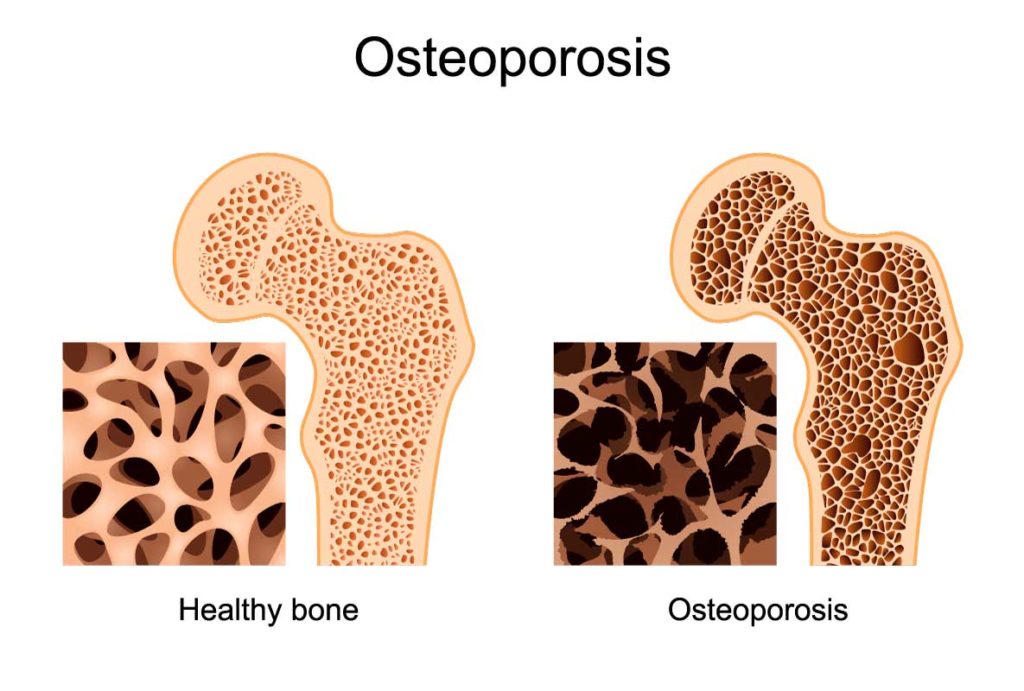By Wesley P. Fairfield, MD, ECNU
What is osteoporosis?
Osteoporosis is a disorder that affects the bones, causing weakness with increased risk of fracture (broken bones). The inside of normal healthy bone has small spaces, like a honeycomb, and osteoporosis increases the size of these spaces resulting in loss of strength and density. The outside rim of the bone also grows weaker and thinner.

Osteoporosis is often called a silent disease because most people with osteoporosis do not feel bones weakening. Breaking a bone is often the first sign of osteoporosis, or people with osteoporosis may notice that they are getting shorter or their upper back is curving forward. Symptoms of severe osteoporosis can include a fracture from a fall or even from a strong sneeze or cough.
How common is osteoporosis?
Approximately 54 million Americans have osteoporosis and low bone mass, which places them at increased risk for osteoporosis. Osteoporosis can occur at any age but is more common in older adults, especially women.
People with osteoporosis are at a high risk of bone fractures while doing routine activities such as standing or walking. The most common affected bones include the ribs, hips, wrists and spine. Approximately one in two women and one in four men age 50 and older will break a bone due to osteoporosis.
Why do people get osteoporosis?
Bone is a dynamic living tissue, and every bone in the body is remodeled, restructured, and reformed about every 7-10 years. Most people reach a peak bone density by age 30 and then lose bone as they age. There are a number of common reasons people may experience accelerated bone loss:
- Having a parent or sibling with osteoporosis puts you at greater risk, especially if your mother or father have a history of hip fracture.
- Women are much more likely to develop osteoporosis than are men.
- Caucasian or Asian descent increases the risk of osteoporosis.
- Long term low calcium intake causes poor bone strength.
- Restricting food intake and low body weight weakens bone.
- Tobacco use weakens bones and drinking more than two alcoholic drinks per day increases the risk of developing osteoporosis.
- People who spend a lot of time sitting have a higher risk of osteoporosis than do those who are more active.
There are many health problems that increase the risk of developing osteoporosis, including: autoimmune disorders; digestive and gastrointestinal disorders; cancer; nervous system disorders; endocrine/hormonal disorders; chronic lung, kidney, and liver disease; poor diet; and weight loss.
Commonly prescribed medications can also cause bone loss, including antacids containing aluminum, antiseizure medicines, cancer chemotherapy, steroids, and many more.
How is osteoporosis diagnosed?
A bone mineral density (BMD) test is an important measure of bone health. The most widely used BMD test is a dual-energy x-ray absorptiometry (DXA) test. This painless, low energy x-ray test of the hip and spine usually takes 10 to 30 minutes. DXA tests can identify osteoporosis, determine the risk of fracture, and assess response to osteoporosis treatments.
What can I do to decrease my risk of having bone fractures?
Without treatment, osteoporosis can worsen. As bones get weaker and thinner, the risk of fracture increases. While there is no cure for osteoporosis, there are medications used to treat it that can help protect and strengthen bones and reduce the risk of getting fractures. Medications help slow the breakdown of bone in the body and some treatments can result in growth of new bone.
Some other factors to consider addressing to reduce the risk of weakening bones, include:
- Nutrition: A balanced diet with a variety of vitamins, minerals, and other important nutrients keeps bones healthy.
- Calcium: Calcium is needed to strengthen bones and 400-500 mg of calcium with each meal from food sources is generally recommended to prevent and treat osteoporosis.
- Vitamin D: Vitamin D is needed for the intestines to be able to absorb the calcium found in foods.
- Exercise: Any weight-bearing exercise and activity that promotes balance and good posture help strengthen bones. Walking, running, jumping, dancing, and weightlifting are particularly helpful.
- Fall prevention: The single most important method of preventing fracture is to prevent falls.
- Lifestyle changes: Drink less alcohol and stop smoking tobacco.
If you have questions, I encourage you to speak with your health care provider about what you can do to keep your bones healthy.

Dr. Wesley Fairfield is a board-certified and Harvard trained endocrinologist who focuses on the treatment of a wide variety of endocrine disorders using the latest therapies. He practices at Northern Light Mercy Endocrinology and Diabetes Care, and his clinical interests include thyroid diseases, osteoporosis, and pituitary disorders. Additional information on the wide range of endocrinology services that he provides can be found here.


